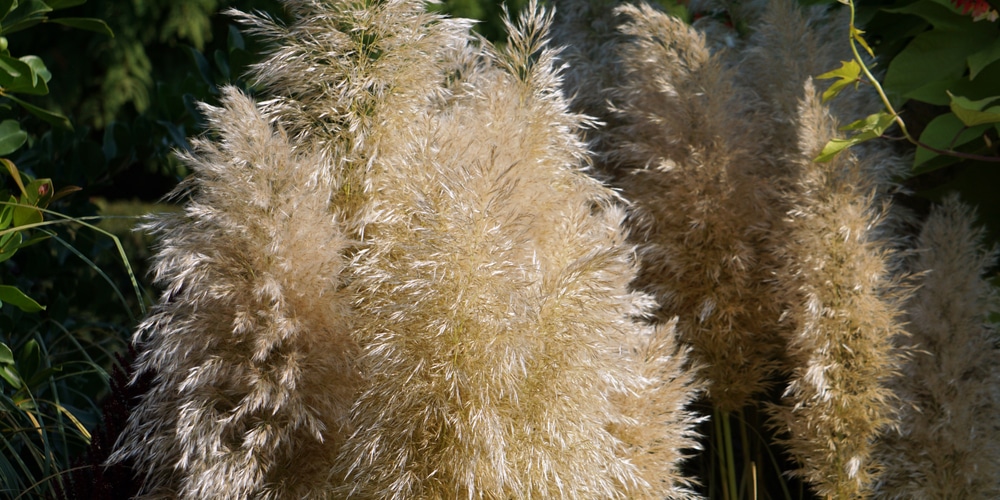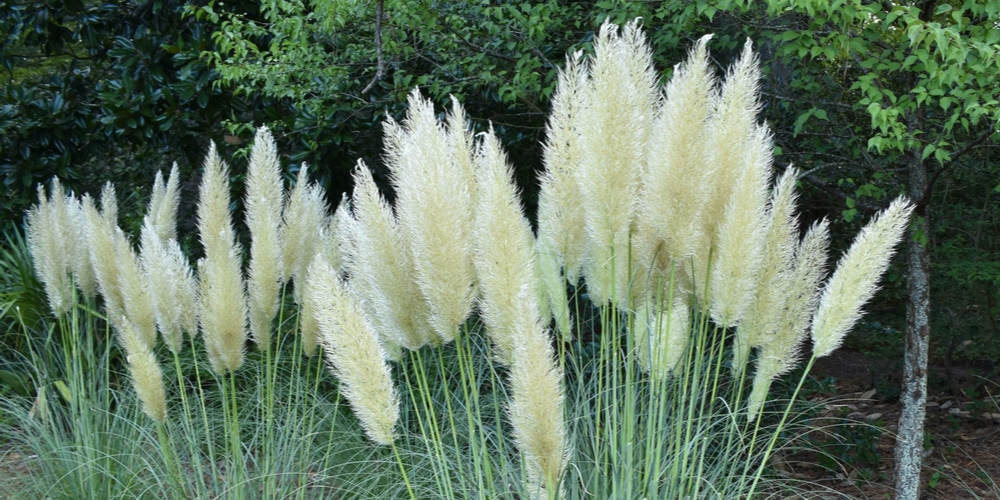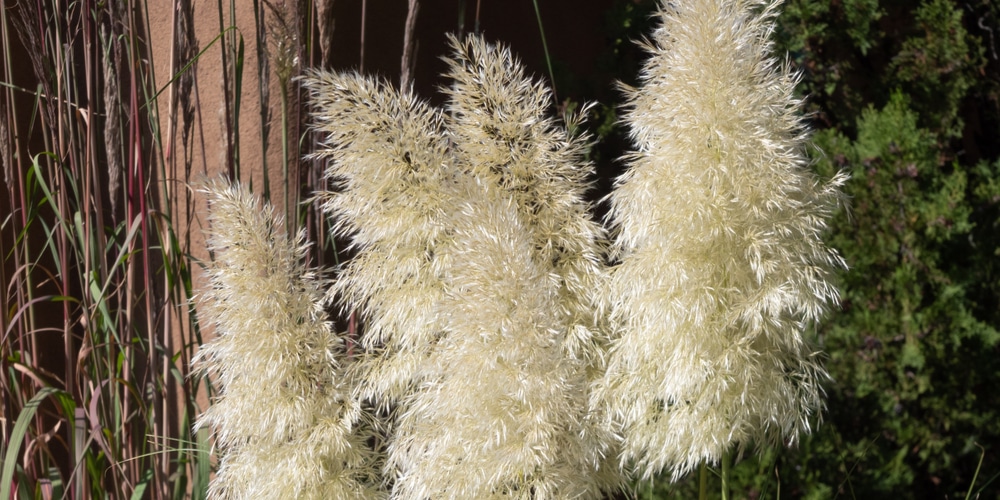Pampas grass is a South American native that’s become a popular ornamental grass in many parts of the world. And it’s no wonder why – with its showy plumes of silvery-white flowers, pampas grass adds a touch of drama to any landscape.
Most varieties are quite easy to grow, and they make a great addition to any garden – whether you have an expansive lawn or just a small corner of your backyard.
There’s something ethereal about dwarf pampas grass. Perhaps it’s the way the long, cascading leaves wave in the breeze or the delicate flowers that bloom atop its slender stems.
Whatever the reason, this graceful plant is a popular choice for gardens large and small. If you’re thinking of adding dwarf pampas grass to your outdoor space, here’s what you need to know about care and maintenance.

| Botanical Name | Cortaderia Pumila |
| Common Name | Dwarf Pampas Grass |
| Plant Type | Perennial |
| Flower Color | Fluffy, white sterile plumes |
| Size When Mature | 36-72 inches |
| Bloom Time | Mid to Late Summer |
| Sun Requirements | Full Sun / Mildly Tolerates partial shade |
| USDA Hardiness Zones | 6-10 |
| Soil PH Range | 6.0 – 7.0 |
| Soil Type | Acidic, Neutral, Loamy, Moist but well-draining |
| Water Needs | Low |
| Native Area | South America |
What You Need to Know About Dwarf Pampas Grass
Prized for its spectacular, feathery foliage and dramatic flower heads, the dwarf pampas grass (Cortaderia Selloana) is a perennial that grows 3-6 feet tall.
It’s a member of the Poaceae family, which includes other popular ornamental grasses like Miscanthus and Pennisetum. Its long and narrow leaves, covered in soft white hairs, resemble puffy clouds and provide a striking contrast against its tall, thin flower stalks.
Dwarf pampas grass is relatively easy to grow and care for, even in areas that don’t have the ideal growing conditions. It produces stunning white plumes from mid-summer to fall and does not require much maintenance.
Dwarf pampas grass has attractive, feathery foliage that can reach up to 6 feet tall. The leaves are long and narrow, covered in soft white hairs. The foliage is topped by dramatic plumes of white flowers that can reach up to 2 feet long in the summer.
How to Care for Dwarf Pampas Grass
Despite its name, dwarf pampas grass is actually a fairly large plant that can grow to 6 feet tall. It does best in full or partial sunlight and thrives in well-draining sandy or clay soil.
To ensure your plants are healthy and happy, here’s everything you need to know about growing and caring for a thriving dwarf pampas grass.
Light
Dwarf pampas grass loves the sun. It thrives well in full sun and can tolerate partial shade. Plant in an area of your garden that receives 6 hours per day, minimum, with some afternoon shade throughout.
This will help prevent the plants from burning in direct sunlight. Moreover, a dwarf pampas plant that receives enough sunlight shows more vibrant colors in its foliage.
While it may tolerate some shade, this plant will not grow well in shady conditions. Its leaves and foliage will become thin and leggy, and it will produce fewer flowers.
If you live in an area with hot summers, planting your dwarf pampas grass in a spot that gets some afternoon shade will help protect it from the intense heat.
Water and Soil Needs
To care for dwarf pampas grass successfully, you must provide adequate water and proper soil conditions. The best way to achieve both of these is to water your plants deeply and consistently, keeping the soil moist but not soggy.
Dwarf pampas enjoys regular watering, with extra attention paid to its solid during hot or dry periods. A deep watering once or twice per week should be sufficient to keep the soil moist and prevents the plant from wilting.
When it comes to the soil itself, dwarf pampas grass prefers a neutral or slightly acidic environment, with a pH of 6.0 to 7.0. The soil should be well-draining, as this plant does not tolerate wet or boggy conditions.
To ensure good drainage, mix in some sand or perlite when planting. A well-draining loamy soil is ideal.
Additionally, it prefers a slightly acidic environment with a pH level between 6.0 and 6.5. Dwarf pampas grass is a drought-tolerant plant, but it will not thrive in dry conditions.
It’s essential to provide consistent moisture, especially during the hot summer months. If the soil around your plants begins to look dry or cracked, give them a good watering.
Temperature Requirements
Thriving in warm conditions, dwarf pampas grass will do best in USDA Plant Hardiness Zones 6 through 10.
In these zones, the plant is likely to reach between 3 and 6 feet tall, with the taller varieties tending more towards the upper end of that range.
If you live in a colder climate, don’t worry! You can still grow dwarf pampas grass successfully.
To keep your plants healthy during the winter season, it’s vital to cover them with a layer of mulch. This will insulate the roots and protect them from the cold weather.
Fertilizer
Fertilize your dwarf pampas grass plants once per year before new growth begins in early spring. Use a balanced fertilizer, such as 10-10-10. This will provide your plants with all of the nutrients they need to thrive throughout the growing season.
In its first year of growing, remember to fertilize this plant at least every 4 months (3 times a year). This will give them a boost and help them grow more vigorously.
Common Diseases
Dwarf pampas grass is a relatively hardy plant that generally takes little work to care for. However, there are a few common diseases and problems that gardeners should keep an eye out for.
For instance, brown spots and dry areas on the tips of the leaves can be a sign of drought stress.
Depending on your climate, you may need to water your grass more frequently or add additional mulch to help retain soil moisture. Another disease that may affect dwarf pampas grass is rust, which manifests as small yellow or orange stripes on the undersides of leaves.
This can be treated by regular applications of fungicide or by removing affected plants and composting them in a separate pile.
Deer and rabbits typically avoid dwarf pampas grass, but other animals, such as groundhogs, moles, and voles, may enjoy feasting on the roots and underground parts of the plant.
The best way to keep these pests away is to surround your plants with wire mesh or a physical barrier.
Dwarf Pampas Grass Propagation
One of the most distinctive features of dwarf pampas grass is its sterile plume, composed of dozens of slender, white threads. This striking flowering structure is actually not an actual flower, but rather an inflorescence known as a spikelet.
Each spikelet contains many small flowers, which are pollinated by wind or insects. Once pollination has occurred, the spikelets will fuse together to form a seed head.
If you are interested in propagating dwarf pampas grass, collecting these seed heads is the best way to get started. The seeds can be sown indoors in late winter or early spring, and they should germinate within 2-3 weeks.
Alternatively, you can collect the seeds in late summer and sow them outdoors after the first frost has passed.
Propagation may also be achieved through division and by taking stem cuttings. It is best to do this in early spring before new growth begins. This will give the newly divided plants plenty of time to establish themselves before the hot summer months arrive.
To propagate by stem cuttings, look for young, softwood branches that have not yet started to harden. Cut them into 3-inch sections and allow the end of each section to callus over for at least 24 hours before planting.
Dwarf Pampas Grass Care: Final Thoughts
For those looking for an easy and low-maintenance grass option for their landscape, dwarf Pampas grass is a great choice. With its lush, variegated blades, it offers plenty of visual interest, and it thrives in a wide range of planting conditions.
To get the most from your dwarf Pampas grasses, be sure to follow the basic care instructions to keep them healthy and vibrant year-round.
This includes regular watering and fertilizing during the growing season and removing old or damaged foliage as needed. With a little care, your dwarf Pampas grasses will thrive and provide your garden and landscape a stunning foliage accent.
Related Article: How Deep are Pampas Grass Rots?

